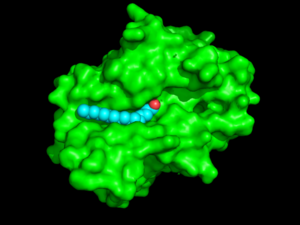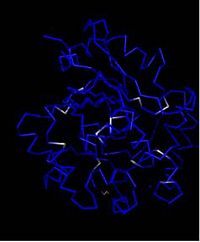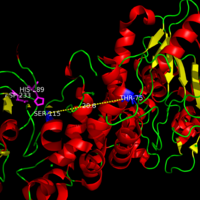Palmitoyl protein thioesterase
From Proteopedia
This page, as it appeared on May 3, 2014, was featured in this article in the journal Biochemistry and Molecular Biology Education.
IntroductionPalmitoyl-protein thioesterase 1 (PPT-1) is a small glycoprotein hydrolase found in the lysosome that breaks the thioester bond between cysteine amino acids and palmitic acid[1]. PPT-1 is a homodimer that is composed primarily of alpha helices and beta sheets with a hydrophobic groove that allows the palmitic acid to bind, exposing the thioester bond to the catalytic triad. PPT-1 was first found as an enzyme that removed palmitate from GTPase HRas and now has many additional cellular substrates [2]. When PPT-1 is not functioning properly, lipid modified proteins can build up in the cells, causing lysosomal storage diseases and aiding in tumor formation [3]. StructureThe secondary structure of PPT1 contains several α-helices and few β-sheets (Figure 1). PPT1 includes residues 28-306, after the 27-residue signal peptide has been removed [4]. An insertion is found between β6 and β7, residues 140-223, and that forms a second domain, shown in blue, that is compromised almost entirely of the fatty acid binding site. This second domain region contains six helices, α2-α7[4]. The α/β hydrolase fold is common to many other hydrolases [4]. The α/β hydrolase fold has a central 6 stranded parallel β-sheet consisting of β3-β8 and α-helices αA, αB, αC, and αF[4]. A catalytic triad and an oxyanion hole are also common features to the PPT1 protein family. None of the enzymes within the α/β hydrolase fold family require a cofactor for catalytic activity. Hydrophobic GrooveThe hydrophobic binding groove where palmitate binds is located in the second domain of PPT1. (This alternate view shows the protein-ligand complex in the same orientation as Figure 1 above for better comparison). The fact that palmitate has to bend to fit into the binding pocket suggests that this pocket is designed to bind an unsaturated fatty acid, with a possible cis-double bond between C4 and C5 (Figure 1)[4]. The top portion of the groove is formed by the residues from α2 to α3. The acid binds in a gauche conformation creating a kink in the acid chain. This bending suggests that PPT-1 was originally designed to react with an unsaturated fatty acid with cis-double bonds. Several residues that are present near the active site create the rest of the groove, including Ile235, Val236, Gln116, Gly40, and Met41[4]. Catalytic TriadThe catalytic triad is composed of Serine-115, Aspartate-233, and Histidine-289 [2]. Ser-115 is deprotonated by His-289 and attacks the carbonyl carbon of the thioester bond connecting palmitic acid to the protein substrate. Ser115 acts as a nucleophile, while His289 and Asp233 are coordinated to Ser115 to lower its pKa value so it can undergo catalytic activity[5]. The pKa of the nucleophile in the catalytic triad is lowered to allow the nucleophilic attack[5]. The negative charge is pushed onto the oxygen and is stabilized in an oxyanion hole. A water molecule is occupying the oxyanion hole and it is hydrogen bonded to Ser115 [5]. The tetrahedral intermediate collapses and kicks the palmatic acid off of the cysteine residue[2]. Inhibitors of PPT-1PPT-1 is a lysosomal enzyme, which has a serine lipase consensus sequence; a key characteristic of lysosomal enzymes. Despite having a serine lipase consensus sequence, PPT-1, is not deactivated by phenylmethylsulfonyl fluoride (PMSF), a common serine-modifying reagent. Hexadecylsulfonylfluoride (HDSF) is a serine-modifying reagent that is able to bind and inhibit PPT-1. Unlike other inhibitors, HDSF is able to fit in the narrow, hydrophobic groove of PPT-1 leading away from the active site of PPT-1. PMSF is unable to fit into this small narrow groove due to steric constraints that relate to the unique structure of the substrate-binding site of PPT-1. The sulphur of HDSF will bind to SER-115 in the active site of PPT-1 via a sulphonylation reaction and thus will inhibit the actions of PPT-1[3].
Disorder Associated With PPT-1Mutations in Palmitoyl Protein Thioesterase 1 (PPT-1) can cause three types of disorders: Infantile Neuronal Ceroid Lipofuscinosis (INCL), Late Infantile Neuronal Ceroid Lipofuscinosis (LINCL), and Juvenile Neuronal Cerioid Lipofuscinosis (JNCL). The severity of most of the mutations are dependent upon their location inside the protein with respect to the catalytic triad. “Mutations that affect catalysis or substrate binding or disrupt proper folding of the core result in inactive enzymes and lead to a severe clinical phenotype” [2]. Other mutations that cause less severe disorders can sometimes retain some residual thioesterase activity. These less severe mutations are believed to have small, local changes in areas of the protein that are far away from the catalytic triad and palmitate binding site. A more detailed explanation of how some of the different disorders arise through mutations is explained below[2]. Infantile Neuronal Ceroid LipofuscinosisInfantile Neuronal Ceroid Lipofuscinosis (INCL) is a recessively inherited disease that is associated with a decrease in PPT-1 activity due to mutations in PPT-1. Onset of symptoms which include retinal blindness, ataxia, seizures, and cortical atrophy of the brain, begin 1-2 years after birth. Death typically occurs between the ages of 8-11. Several mutations in the 1p32 chromosome have been identified to cause INCL [2].
Mutations leading to Infantile Neuronal Ceroid LipofuscinosisVarious mutations have been found in INCL patients[6]. Most of these mutations are caused by nonsense or missense mutations within close proximity to the catalytic triad. These mutations lead to an inactive PPT-1 enzyme as they are predicted to create unfavorable steric, polar, and electrostatic interactions that could disturb the nucleophilic elbow [2]. The nucleophilic elbow is responsible for proper location and orientation of the Ser-115. The catalytic activity of PPT-1 is greatly reduced if the positioning of Ser-115 is altered, as Ser-115 must be properly orientated to be activated by His-289 to be positioned to attack the substrate. An example of a INCL mutation such as Val181Met and Glu184Lys gives a good depiction of how the increase in size in the mutated amino acids and positive charge on the inserted lysine residue would create steric and polar clashes with the adjacent helices of the binding pocket compared to the normal Val-181 and Glu-184. Normal Arg-122 which is below [6]. (*All mutation scenes are the proposed best rotamers of the mutation. These mutations were created through the use of the mutagenesis wizard in the PyMOL program)
Known INCL Mutations 1. Arg122Trp 2. Phe225Ser 3. Gly118Asp 4. Gly42Gln 5. Tyr109Asp 6. His39Asp 7. Glu184Lys 8. Val181Met Arg122TrpThe most common mutation in INCL that occurs in PPT-1 is a single missense mutation of Arg122Trp. Arg-122 is located immediately after the nucleophilic elbow of PPT-1. The sidechain of Arg-122 has a main function to control the spacing between the αC and α6 helices in this region. This is done by Arg-122 having three hydrogen bonds with three adjacent amino acids: Ile-205, Asn-206, and Gln-205. Mutation of Arg-122 to Trp means not only a loss of those three hydrogen bonds but also a steric and polarity mismatch with the surrounding residues [2]. These steric clashes will cause a misfolding of the enzyme’s core and cause it to be trapped in the endoplasmic reticulum, which results in no detectable PPT-1 activity. Late-Infantile and Juvenile Neuronal Ceroid LipofuscinosisJuvenile NCL (JNCL) and Late-Infantile NCL (LINCL) are less severe forms of INCL in which onset of symptoms occur much later in life; between the ages of 30-40. A possible explanation for the later onset of symptoms could be that the mutations associated with JNCL and LINCL occur away from the active site of PPT-1. Since the mutation does not affect the active site this results in a higher activity of the PPT-1 enzyme. A common mutation associated with JNCL and LINCL involves the mutation of Thr-75, an amino acid located on the alpha-1 helix of PPT-1 (Figure 4). The Thr-75 amino acid is located 20.6Å away from the active site of PPT-1 which indicates that Thr-75 plays no role in the catalytic activity of the catalytic triad [2]. In both JNCL and LINCL, the activity of PPT-1 is at only 2% of the normal activity rate of PPT-1. This suggests that a small increase in activity of PPT-1 may aid in delaying the symptoms associated with INCL, LINCL, and JNCL. One way to potentially increase the activity of mutant PPT-1 variants is to use protein chaperones that help refold PPT-1 in the endoplasmic reticulum. Although this is not a cure for INCL, increasing the activity of PPT-1 by only two-fold can also increase the life expectancy for individuals with INCL [7]. Despite the life-threatening disorders associated with decreased PPT-1 activity, inhibition of PPT-1 has also been shown to be a potential cancer target. Proteins involved in signaling and growth are post-translationally modified with palmitic acid. PPT-1 is involved with removing palmitate from lipid-modified proteins and this palmitoylation is necessary for membrane association. When PPT-1 is over expressed, cells become protected from cell death, which leads to tumor formation. PPT-1 inhibition in cultured tumor cells led to selective tumor cell death [7]. Mutations leading to Late-Infantile Neuronal Ceroid LipofuscinosisLINCl is caused by a mutation in the CLN2 gene which “codes for a lysosomal pepstatin-insensitive acid protease that is deficient in LINCL patients”[8]. Mutations that tend to lead to LINCL still disrupt the active site and binding pocket geometry, but not to the degree that is seen in INCL. One LINCL mutation is Gln177Glu. Gln-177 acts as a hydrogen bond donor to Ala-171 and Ala-183 and as a hydrogen bond acceptor from Ile-200. The mutation of Gln-177 likely causes a conformation change of the helices in the area. Ala-171 and Ala-183 make hydrophobic contact with the palmitate, and so the altered conformation associated with those two amino acids would decrease binding affinity of the palmitate, decreasing, but not killing the catalytic activity of PPT-1. Mutations leading to Juvenile Neuronal Ceroid LipofuscinosisJNCL is caused by a mutation in the CLN3 gene which codes for a lysosomal membrane protein of unknown function [9]. Unlike the mutations that cause INCL and LINCL, mutations that lead to JNCL are located away from the active site and are seen to cause less damage to the overall structure of PPT-1. Some of the mutations in JNCL have been noted as retaining a low level of PPT-1 activity as the catalytic site is left fairly unperturbed. Mutations associated with JNCl are found in two locations, Thr75Pro with Asp79Gly and Tyr247His with Gly250Val. These mutations occur in conjugate with its other pair and are predicted to disturb the geometry of helix α1, increasing the flexibility of the region, and alter the antiparallel βsheet motif in sheets βa and βb compared to the normal Tyr-247 and Gly-250. 3D structures of palmitoyl protein thioesterase
|
| |||||||||||
References
- ↑ Wang R, Borazjani A, Matthews AT, Mangum LC, Edelmann MJ, Ross MK. Identification of palmitoyl protein thioesterase 1 in human THP1 monocytes and macrophages and characterization of unique biochemical activities for this enzyme. Biochemistry. 2013 Oct 29;52(43):7559-74. doi: 10.1021/bi401138s. Epub 2013 Oct, 18. PMID:24083319 doi:http://dx.doi.org/10.1021/bi401138s
- ↑ 2.0 2.1 2.2 2.3 2.4 2.5 2.6 2.7 2.8 Bellizzi JJ 3rd, Widom J, Kemp C, Lu JY, Das AK, Hofmann SL, Clardy J. The crystal structure of palmitoyl protein thioesterase 1 and the molecular basis of infantile neuronal ceroid lipofuscinosis. Proc Natl Acad Sci U S A. 2000 Apr 25;97(9):4573-8. PMID:10781062 doi:10.1073/pnas.080508097
- ↑ 3.0 3.1 Simonati A, Tessa A, Bernardina BD, Biancheri R, Veneselli E, Tozzi G, Bonsignore M, Grosso S, Piemonte F, Santorelli FM. Variant late infantile neuronal ceroid lipofuscinosis because of CLN1 mutations. Pediatr Neurol. 2009 Apr;40(4):271-6. doi: 10.1016/j.pediatrneurol.2008.10.018. PMID:19302939 doi:http://dx.doi.org/10.1016/j.pediatrneurol.2008.10.018
- ↑ 4.0 4.1 4.2 4.3 4.4 4.5 Bellizzi JJ 3rd, Widom J, Kemp C, Lu JY, Das AK, Hofmann SL, Clardy J. The crystal structure of palmitoyl protein thioesterase 1 and the molecular basis of infantile neuronal ceroid lipofuscinosis. Proc Natl Acad Sci U S A. 2000 Apr 25;97(9):4573-8. PMID:10781062 doi:10.1073/pnas.080508097
- ↑ 5.0 5.1 5.2 Branneby, Cecilia. "Exploiting Enzyme Promiscuity for Rational Design." KTH Biotechnology (2005): Web. 10 Apr. 2013.
- ↑ 6.0 6.1 Hofmann SL, Das AK, Yi W, Lu JY, Wisniewski KE. Genotype-phenotype correlations in neuronal ceroid lipofuscinosis due to palmitoyl-protein thioesterase deficiency. Mol Genet Metab. 1999 Apr;66(4):234-9. PMID:10191107 doi:http://dx.doi.org/10.1006/mgme.1999.2803
- ↑ 7.0 7.1 Dawson G, Schroeder C, Dawson PE. Palmitoyl:protein thioesterase (PPT1) inhibitors can act as pharmacological chaperones in infantile Batten disease. Biochem Biophys Res Commun. 2010 Apr 23;395(1):66-9. doi:, 10.1016/j.bbrc.2010.03.137. Epub 2010 Mar 25. PMID:20346914 doi:http://dx.doi.org/10.1016/j.bbrc.2010.03.137
- ↑ Vines DJ, Warburton MJ. Classical late infantile neuronal ceroid lipofuscinosis fibroblasts are deficient in lysosomal tripeptidyl peptidase I. FEBS Lett. 1999 Jan 25;443(2):131-5. PMID:9989590
- ↑ Mitchison HM, Taschner PE, Kremmidiotis G, Callen DF, Doggett NA, Lerner TJ, Janes RB, Wallace BA, Munroe PB, O'Rawe AM, Gardiner RM, Mole SE. Structure of the CLN3 gene and predicted structure, location and function of CLN3 protein. Neuropediatrics. 1997 Feb;28(1):12-4. PMID:9151311 doi:http://dx.doi.org/10.1055/s-2007-973656
Similar Proteopedia Pages
Category:Palmitoyl_protein_thioesterase
External Resources
Gauche Effect Wikipedia page
Palmitic acid Wikipedia page
Infantile Neuronal Ceroid Lipofuscinosis Wikipedia page
PMSF Wikipedia page
Protein Chaperones Wikipedia page
Endoplasmic reticulum Wikipedia page
Palmitoylation Wikipedia page
Page on Late Infantile neuronal Ceroid Lipofuscinosis
Page on Juvenile neuronal Ceroid Lipofuscinosis
Student Contributors
Andrew Bartels
Nicole Green
Kelly Maddalone
Ryan Mughmaw
Audrey Wright
Proteopedia Page Contributors and Editors (what is this?)
R. Jeremy Johnson, Karsten Theis, Alexander Berchansky, Angel Herraez, Michal Harel





